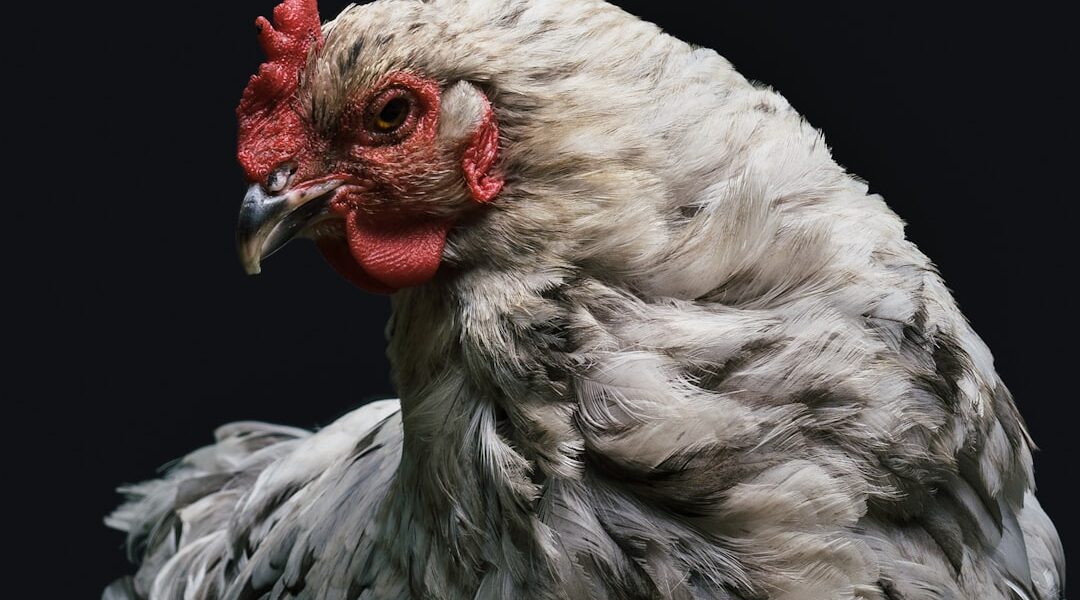The Lavender Orpington is a breed of chicken that has gained popularity among chicken enthusiasts for its beautiful appearance and friendly temperament. This breed is known for its striking lavender-colored feathers, which set it apart from other varieties of Orpington chickens. Lavender Orpingtons are a dual-purpose breed, meaning they are suitable for both meat and egg production. They are also known for their docile and friendly nature, making them a great addition to any backyard flock.
Key Takeaways
- The Lavender Orpington is a beautiful and popular breed of chicken.
- This breed originated in England in the early 1900s and was created by William Cook.
- Lavender Orpingtons are known for their fluffy feathers, gentle personalities, and excellent egg-laying abilities.
- Raising Lavender Orpingtons can provide many benefits, including a reliable source of fresh eggs and a fun and rewarding hobby.
- To care for Lavender Orpingtons, you will need to provide them with a safe and comfortable living space, a nutritious diet, and regular veterinary check-ups.
History and Origin of the Lavender Orpington Breed
The Lavender Orpington breed originated in England in the late 1800s. It was developed by William Cook, who was also responsible for creating the original Orpington breed. Cook aimed to create a chicken that was not only productive but also had an attractive appearance. The Lavender Orpington was developed by crossing black Orpingtons with other breeds, such as Cochins and Langshans, to introduce the lavender color variation.
The lavender color variation in Orpington chickens is a result of a dilution gene that affects the expression of black pigment in the feathers. This gene creates a beautiful lavender or blue-gray coloration in the plumage of Lavender Orpingtons. The Lavender Orpington breed was first recognized by the American Poultry Association in 2016 and has since gained popularity among chicken enthusiasts in the United States.
Characteristics and Appearance of the Lavender Orpington
Lavender Orpingtons are large birds with a broad, deep body and a low stance. They have a medium-sized single comb and medium-sized wattles that are red in color. The comb and wattles should be free from any deformities or discoloration. The eyes of Lavender Orpingtons are typically reddish-brown, and their beaks are yellow. They have a medium-length neck and a short, broad tail.
The most distinctive feature of Lavender Orpingtons is their lavender-colored feathers. The lavender coloration is evenly distributed throughout the body, including the head, neck, back, wings, and tail. The feathers have a soft, fluffy appearance, which adds to the breed’s overall charm. The lavender color can vary in intensity, with some birds having a lighter shade and others having a deeper, more vibrant hue.
Personality and Temperament of the Lavender Orpington
Lavender Orpingtons are known for their docile and friendly nature. They are calm and easy to handle, making them a great choice for families with children or first-time chicken owners. These chickens enjoy human interaction and are often described as being “lap chickens” due to their tendency to seek out human companionship. They are not aggressive and get along well with other breeds in a mixed flock.
One characteristic of Lavender Orpingtons that should be noted is their tendency to be broody. Broodiness is when a hen becomes determined to sit on her eggs and hatch them into chicks. While this can be desirable if you want to raise chicks, it can also disrupt egg production if you are primarily interested in collecting eggs for consumption. However, their broodiness can be managed by providing them with suitable nesting boxes and removing any eggs they may try to sit on.
Benefits of Raising Lavender Orpingtons in Your Flock
One of the main benefits of raising Lavender Orpingtons in your flock is that they are a dual-purpose breed. This means that they are suitable for both meat and egg production. The hens are good layers and can produce around 150-200 large brown eggs per year. The meat of Lavender Orpingtons is also highly regarded for its flavor and tenderness, making them a great choice for those who want to raise their own meat.
In addition to their productivity, Lavender Orpingtons are also known for their attractive appearance. The lavender-colored feathers make them stand out in any flock and are sure to be a conversation starter. Their soft, fluffy plumage adds to their charm and makes them a delight to look at. Whether you are raising chickens for practical purposes or simply for the joy of having them in your backyard, Lavender Orpingtons are sure to bring beauty to your flock.
Furthermore, the calm and easy-to-handle nature of Lavender Orpingtons makes them a pleasure to have as pets. They are not flighty or skittish like some other breeds and are more than happy to be held and cuddled. This makes them a great choice for families with children or anyone who wants a friendly and sociable chicken.
Housing and Care Requirements for Lavender Orpingtons

When it comes to housing and care requirements, Lavender Orpingtons have similar needs to other chicken breeds. They require a secure coop and run that provides protection from predators such as foxes, raccoons, and birds of prey. The coop should be well-ventilated and provide enough space for the number of chickens you plan to keep. As a general guideline, each chicken should have at least 4 square feet of coop space and 10 square feet of run space.
Bedding is an important consideration for the comfort and health of your Lavender Orpingtons. Pine shavings or straw can be used as bedding material in the coop. The bedding should be kept clean and dry to prevent the buildup of moisture, which can lead to bacterial growth and respiratory issues in chickens.
Lavender Orpingtons require suitable nesting boxes for laying their eggs. Each hen should have her own nesting box, which should be filled with clean straw or shavings. The nesting boxes should be placed in a quiet and secluded area of the coop to provide privacy for the hens.
Feeding and Nutrition of Lavender Orpingtons
Lavender Orpingtons have similar feeding and nutritional requirements to other chicken breeds. They should be fed a balanced diet that consists of a commercial layer feed or a mix of grains and pellets specifically formulated for laying hens. The feed should contain the necessary nutrients, vitamins, and minerals to support egg production and overall health.
In addition to their regular feed, Lavender Orpingtons should have access to fresh, clean water at all times. Chickens can drink a surprising amount of water, especially during hot weather, so it is important to regularly check and refill their water containers.
Treats and snacks can be given to Lavender Orpingtons in moderation as a supplement to their regular diet. Some suitable treats include fruits, vegetables, mealworms, and scratch grains. However, it is important not to overdo it with treats, as they should only make up a small portion of the chickens’ overall diet.
Breeding and Incubation of Lavender Orpingtons
Breeding Lavender Orpingtons requires careful consideration to ensure the production of healthy and true-to-type offspring. It is important to select breeding stock that meets the breed standard in terms of appearance and temperament. Breeding birds should be free from any deformities or genetic issues that could be passed on to their offspring.
When it comes to incubating eggs, Lavender Orpingtons are known for being good mothers and often make excellent broody hens. However, if you do not have a broody hen or want to hatch eggs artificially, you can use an incubator. The incubation period for chicken eggs is approximately 21 days, and the temperature and humidity levels in the incubator should be carefully monitored and adjusted according to the manufacturer’s instructions.
Caring for Lavender Orpington chicks is similar to caring for chicks of other breeds. They should be kept in a brooder with a heat source, such as a heat lamp or a brooder plate, to maintain a temperature of around 95 degrees Fahrenheit for the first week. The temperature can then be gradually reduced by 5 degrees each week until the chicks are fully feathered and can regulate their own body temperature.
Health Concerns and Common Issues for Lavender Orpingtons
Lavender Orpingtons, like all chickens, are susceptible to certain health issues and common problems. Some common health issues that can affect Lavender Orpingtons include respiratory infections, parasites, and egg-laying problems. It is important to regularly monitor your chickens for any signs of illness or distress and take appropriate measures to prevent and treat these issues.
Preventative measures for maintaining the health of your Lavender Orpingtons include providing them with a clean and dry living environment, regular deworming, and vaccinations against common poultry diseases. It is also important to practice good biosecurity measures, such as limiting contact with other flocks and disinfecting equipment and footwear before entering the chicken area.
If you notice any signs of illness or injury in your Lavender Orpingtons, it is important to seek veterinary care. A veterinarian who specializes in poultry health can provide a proper diagnosis and recommend appropriate treatment options.
Why the Lovely Lavender Orpington is a Must-Have for Your Flock
In conclusion, the Lovely Lavender Orpington is a breed of chicken that offers many benefits and characteristics that make it a must-have for any flock. From its beautiful lavender-colored feathers to its friendly and docile nature, Lavender Orpingtons are a joy to have in the backyard. They are a dual-purpose breed, suitable for both meat and egg production, and their attractive appearance adds beauty to any flock.
When it comes to housing and care requirements, Lavender Orpingtons have similar needs to other chicken breeds. They require a secure coop and run, suitable bedding, and nesting boxes for laying eggs. Feeding and nutrition should consist of a balanced diet of commercial feed and fresh water, with treats given in moderation.
Breeding and incubation of Lavender Orpingtons require careful consideration to ensure the production of healthy offspring. Caring for chicks involves providing them with a suitable brooder environment and gradually reducing the temperature as they grow.
While Lavender Orpingtons are generally healthy birds, it is important to be aware of common health issues and take preventative measures to maintain their well-being. Regular monitoring, good biosecurity practices, and seeking veterinary care when necessary are all important aspects of keeping your Lavender Orpingtons healthy.
Overall, the Lovely Lavender Orpington is a breed that offers beauty, productivity, and a friendly temperament. Whether you are a seasoned chicken enthusiast or new to raising chickens, adding Lavender Orpingtons to your flock is sure to bring joy and satisfaction.
If you’re a fan of lavender Orpington chickens, you’ll definitely want to check out this fascinating article on the Performing Rail website. Titled “Hello World,” it delves into the history and characteristics of lavender Orpingtons, providing valuable insights for both seasoned breeders and newcomers to the world of poultry. Discover the unique traits and stunning appearance of these beautiful birds by clicking here.
FAQs
What is a Lavender Orpington?
A Lavender Orpington is a breed of chicken that is known for its unique lavender-colored feathers. It is a large, docile bird that is popular among backyard chicken keepers.
Where did Lavender Orpingtons originate?
Lavender Orpingtons were first bred in England in the early 20th century by William Cook. They are a variety of the Orpington breed, which was developed in the town of Orpington in Kent, England.
What are the characteristics of a Lavender Orpington?
Lavender Orpingtons are known for their calm and friendly personalities. They are a large breed, with hens weighing around 7-8 pounds and roosters weighing around 10-12 pounds. They have a fluffy appearance due to their soft, downy feathers. Their feathers are a unique lavender color, which is a result of a dilution gene.
What is the purpose of raising Lavender Orpingtons?
Lavender Orpingtons are primarily raised for their eggs and meat. They are known for their large brown eggs and their tender, flavorful meat. They are also popular among backyard chicken keepers as pets due to their friendly personalities and unique appearance.
What is the lifespan of a Lavender Orpington?
The lifespan of a Lavender Orpington is typically around 8-10 years, although some have been known to live longer with proper care.
What is the care required for raising Lavender Orpingtons?
Lavender Orpingtons require basic care, including access to clean water and a balanced diet of chicken feed and fresh fruits and vegetables. They also need a safe and secure coop to protect them from predators. Regular cleaning of the coop and nesting boxes is also important for their health and hygiene.




